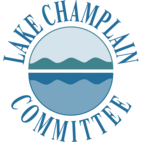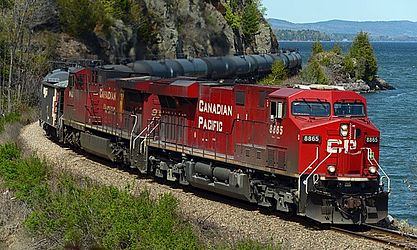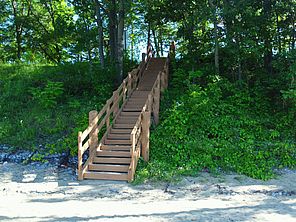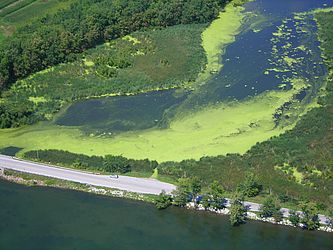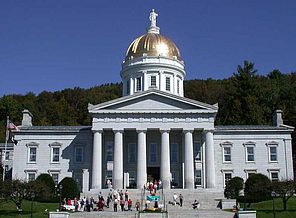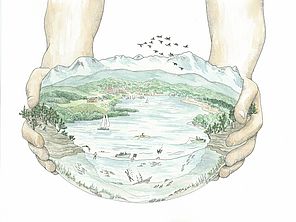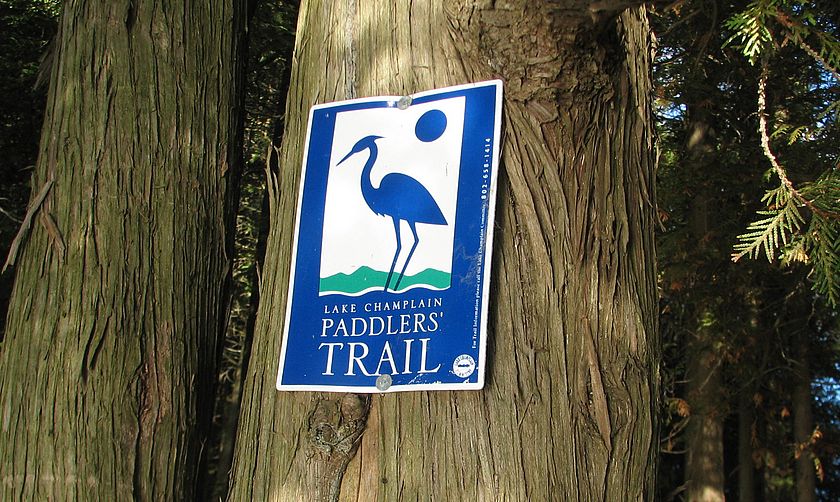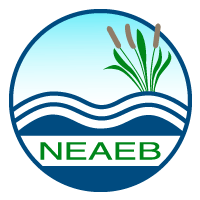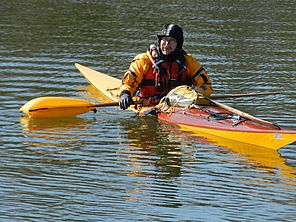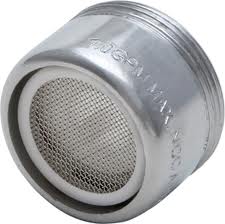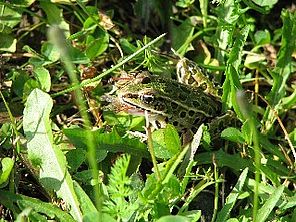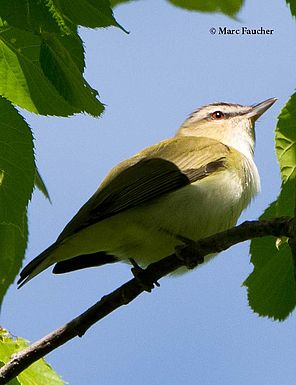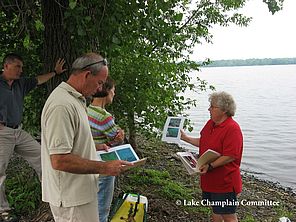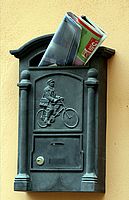LCC May E-News - Risky Oil Transport, Biology Slams, Legislative Updates, Friday Bird Walks, Water Matters and More
Rail Transport of Oil Poses Lake Risk
The sound of trains clacking along the rails that abut Lake Champlain has become more common recently with the dramatic increase in freight traffic attributed to fossil fuel extraction. Each week approximately 60 million gallons of oil travel along the lake carried by 20 trains with up to 100 cars each. The U.S. now meets 66 percent of its crude oil demand from production in North America with tremendous growth in outputs from Canada and the Bakken oil fields of North Dakota. In October 2013 U.S. crude oil production exceeded imports for the first time since February 1995.
Oil produced from the Bakken fields is very light. That means it flows easily, but it also means it is more volatile and flammable. As a result, the potential property damage and loss of life associated with rail accidents involving Bakken oil is higher than oil from other sources. In January of this year two federal agencies issued a safety alert warning of these risks.
The alert was triggered by a series of devastating accidents. The Federal Railroad Administration statistics suggest that on average at least one car slips off the tracks every day. There have been six major derailments between the beginning of 2013 and mid-January 2014. The most infamous occurred on July 5, 2013 in Lac Megantic, Quebec. An improperly secured train began rolling on its own, and 63 cars derailed near the center of town. Derailment led to multiple explosions and fires, evacuation of 2,000 people, and 47 fatalities. On October 19, 2013, 13 tank cars derailed in Alberta leading to evacuation of 100 residents. Three cars carrying propane burned following an explosion. On November 8, 2013 30 cars derailed in a wetland near Aliceville, Alabama and about a dozen were decimated by fire. On December 30, 2013, two trains, one carrying grain and one oil, collided in Casselton, North Dakota. Twenty of the oil train cars derailed and exploded leading to evacuation of 1,400 people. On January 7, 2014, 17 cars derailed in New Brunswick and five exploded leading to evacuation of 45 people. On January 20, 2014 seven cars derailed on a bridge over the Schuylkill River in Philadelphia, though no oil leaked. More recently, 15-17 cars derailed in Lynchburg, VA on April 30. Three fell into the James River and one burst into flames. There were no injuries but 300-350 people had to be evacuated and oil leaked into the James River. The state estimated 20,000 to 25,000 gallons escaped during the wreck.
Our region is no stranger to train derailments. Continue reading on LCC's website.
Planning Shoreline Protection Projects
In the midst of another spring of high water we remember the floods of 2011 that brought widespread devastation to the Champlain Basin. A large snow pack and extensive spring rains swelled Lake Champlain to a record height of 103.27 feet above sea level. The lake reached flood stage (100 feet) on April 13 and stayed above that level for 67 days. Lakeside homes, roads and buildings were inundated and battered by wind-driven waves. Flood damage along the lake can be caused by inundation, wind, waves, currents and ice.
Property owners use a variety of methods to stabilize eroding shoreland, but poorly designed projects can be very expensive and unattractive, and harm the lake ecosystem, without even adequately protecting the shoreline. Lake Champlain’s shore along Appletree Bay in Burlington’s New North End offers examples of successful and unsuccessful projects to treat shoreline erosion. Appletree Bay offers stunning vistas to the west across the broad lake. The views are a prime attraction and large homes have sprouted along the shore. But the broad lake generates large waves here and the area’s sandy soils are especially susceptible to erosion. Cruising along the shore one can see many examples of shoreline stabilization projects.
The Little Eagle Bay development consists of townhouses and one-bedroom flats, some of which sit right on the shore of Lake Champlain. The property managers built a massive sea-wall to protect their investment. Within a few years of construction however, the wall was tilting out over the lake and its structural integrity was weakened.
What went wrong? The wall was designed to dampen the force of lakeside waves, but the developers failed to account for the pressure of down-slope movement of land toward the lake. Continue reading on LCC's website.
Do TMDLs Work?
Vermont has been working on revising a lake clean-up budget as directed by the Environmental Protection Agency. What are the chances that the budget will lead to a cleaner lake? Disturbingly low if the plan follows the track of others like it reviewed in a recent General Accounting Office (GAO) report released earlier this year.
For the report, the GAO examined a random sample of 25 long-established (greater than 5 years) pollution budgets for impaired waters known as Total Maximum Daily Loads or TMDLs, and surveyed state officials tasked with carrying out an additional 191 long-established TMDLs. TMDLs allocate allowable pollution loads between sources that require federal permits like factories and wastewater plants, called point sources and all other sources, lumped together as non-point sources. They also require allowances for pollution from future growth and a margin of safety. EPA approved a TMDL for Lake Champlain in 2002 but later revoked that approval. Vermont and EPA are in the process of crafting a new TMDL for the lake.
Of the 25 TMDLs the GAO surveyed, 17 did not show that addressing the identified pollutant would lead to meeting water quality standards; 12 contained vague or no information on actions needed; and 15 did not include provisions for revising the TMDLs. While the TMDLs were effective at eliminating pollution from point sources with 80 percent reaching their goals, they were less effective at eliminating pollution from diffuse non-point sources, and only 20 percent reached these goals. The vast majority of Lake Champlain's pollution problem comes from non-point sources. EPA has limited authority over non-point sources and depends on voluntary measures.
The GAO identified two significant problem areas beyond the authority of states and EPA. First, EPA has no authority to compel private parties to address non-point sources of pollution. EPA's authority is limited to point sources. When Congress revised the Clean Water Act in 1987 they retained the voluntary approach for non-point source pollution, but may need to reconsider this limitation. Second, both states and EPA face budget constraints that limit their ability to address important pollution sources. Cleaning up our nation’s waters will be expensive. GAO recommended that EPA issue new regulations for TMDL development and that Congress consider revising the Clean Water Act’s approach to addressing non-point source pollution.
The GAO also made a series of additional suggestions that could improve TMDLs, some of which could also help on Lake Champlain. Here are some of GAO’s recommendations and how well the draft Lake Champlain TMDL complies with them: Continue reading on LCC's website.
Legislative Update
In the 2014 Vermont Legislative session the legislature debated bills to increase requirements for protecting lake shores, regulate toxic chemicals and provide more funding for water quality projects. The lake shore protection bill passed and awaits the Governor's signature, the toxics bill is still being debated but the water quality funding bill fell apart. The New York legislature has been considering a bill to eliminate microbeads from cosmetics after such beads were found polluting the Great Lakes. Read on for more information on each of the bills:
Shoreline protection - The biggest bill affecting water quality to come out of the Vermont Legislature this session affects efforts to protect lakeshores. After the Vermont House passed a bill last year a committee of the House and Senate spent the summer touring the state to hear feedback on the proposal. The Senate then passed a bill with much more detail than the original House version. The Vermont House and Senate agreed on compromise language in the shoreline protection bill. The compromise allows towns with ‘functionally equivalent’ standards to administer their own program as requested by the House, but it keeps standards in the bill rather than deferring them to the Agency of Natural Resources as the Senate requested. The bill requires a permit for significant clearing of vegetation or expansion of impervious surface along lake shores. Clearings of less than 100 square feet of vegetation at least 25 feet from the shore or construction of less than 500 square feet of impervious surface would not require a permit, but would require registration. Continue reading on LCC's website.
Vermont Water Caucus
In late March, LCC joined with a number of other organizations interested in lakes and rivers to discuss ways to advance water quality policy in Vermont. The meeting was the first statewide effort to build grassroots support to protect Vermont’s waters. Discussion centered on pending legislation in Montpelier, proposals put forth by the Department of Environmental Conservation to amend the water quality standards, and processes to ensure the caucus is efficient and effective. The group intends to meet quarterly to discuss issues and organize positions to advance water quality policy. Many thanks to VNRC for organizing this group.
2014 Guidebook - Your Ticket to Travel the Trail!
The 2014 Lake Champlain Paddlers' Trail Guidebook will be out soon. This year's edition is filled with important information for great adventures on the water including site descriptions and chartlets for all the trail locations, launch site listings, natural history articles, safety and stewardship tips, equipment checklists and more! The guidebook isn't sold, it's only available through a yearly LCC membership of $45 or more. Annual memberships support LCC's Trail development and the work for a healthy, accessible lake. Join or renew your LCC membership to ensure you have the guidebook in hand when the water warms up. In the interim you can brush up on safety and trail ethics before you get out on the water in the Explore section of LCC's website.
LCC Slams for Biologists
How much information can you convey in five minutes? That was the challenge presented at the Slam session of the recent meeting of the New England Association of Environmental Biologists. LCC Staff Scientist Mike Winslow delivered a Slam talk about the use of volunteers in monitoring blue-green algae blooms on Lake Champlain. The Slam talks were used to pique the interest of the audience who then engaged in an hour and a half discussion session. The conference was hosted by the Vermont Department of Environmental Conservation with assistance from the New England Interstate Water Pollution Control Commission and the Lake Champlain Basin Program. The conference provides an annual forum for exchange of ideas and presentations of projects, research, and technology to help advance environmental protection in the New England region.
Cold Water Caution
Even if air temperatures seem balmy, the lake takes much longer to warm up. Additionally, strong currents and springtime debris are potential marine hazards this time of year. Lake Champlain temperatures are still in the 40s. If you are immersed in water that cold, you lose dexterity in less than five minutes and exhaustion and unconsciousness can set in after 30 minutes. Water temperatures of less than 70 degrees Fahrenheit can cause you to lose precious body heat up to 25 times faster than comparable air temperatures.
Water temperatures in many areas of Lake Champlain, particularly the Main Lake, never reach the 70s. Be cautious about heading out on the water and make sure you and your boat are properly equipped. Bring a weather radio or VHF with you and check the weather forecast repeatedly. Always wear a Personal Flotation Device (PFD). Nine out of ten drownings occur in inland waters, most within a few feet of safety. Most of the victims owned PFDs but died not wearing them. A properly fitted, buoyant PFD can save your life, but only if you wear it.
Dress for the season. If kayaking or canoeing in cold water conditions (no matter what the air temperature is) wear a wetsuit or drysuit with an insulating layer. Here's to safe, fun adventures on the water!
Water Conservation Matters
Why conserve water in a wet environment like the Lake Champlain basin? Wasted water contributes to lake pollution. Sewage treatment plants remove phosphorus and other pollutants from the water that leaves our homes and businesses but the efficiency of that removal decreases when sewage is diluted by leaked tap water. Also, municipal drinking water systems often add a phosphorus-containing compound to drinking water to prevent lead from leaching from old pipes. This compound must then be removed from wastewater before it enters Lake Champlain. Removal is not 100 percent efficient, so wasted water leads to additional lake pollution.
Wasting water also wastes energy. The biggest use of electricity in many communities is supplying water and cleaning it up after it's been used. A lot of energy is consumed to collect, transport, treat and deliver water and wastewater. Water must be pumped from its source to its end use in houses, apartments, businesses and institutions then collected again for treatment. Reducing water use and fixing leaks saves money and lessens demands on the energy-intensive systems that deliver, treat and heat water. Download LCC's new flier for tips on how to conserve water indoors and out.
Nature Note - High Water Paddling
The high waters of early spring flood low-lying forested areas offer an excellent opportunity to maneuver your kayak or canoe through the trees and button bush of floodplains and back waters. Flooded navigable habitat can be found at the mouths of most major creeks and rivers along the lake. In Vermont, check the Missisquoi, Otter, Little Otter, Lewis, Poultney Rivers. In New York, the Ausable and Little Ausable provide opportunities.
Wood ducks will be seeking tree cavities for nesting sites; you’re most likely to hear them first as their squawks echo through the forest ahead of your boat. A surprising thud under the boat could be an encounter with a carp that has moved into the area for spawning. In the broader waters near the lake the long raspy drone of pickerel frogs or the slow creaky door calls of leopard frogs are more common than the spring peepers of tiny vernal pools further inland. By summer the water levels will drop and plant growth will make these areas inaccessible. Enjoy them while you can but remember waters are still chilly; dress and prepare accordingly.
Upcoming Events Around the Region
Friday Bird Walks - May 2014
Join LCC Staff Scientist Mike Winslow for Friday morning bird walks beginning at Burlington's Oakledge Park at 8:00 AM. Stroll along the lakeshore and learn to identify birds by sight and sound. Take in Lake Champlain and Adirondack views, learn about birds and ask lake questions. Weekly events last about an hour, are free, and will be held rain or shine. Our final bird walk of the spring will be on May 30 and end with a light breakfast on the back porch of LCC’s 208 Flynn Avenue office. Meet and park at Oakledge Park, not along Flynn Avenue (parking fees apply after Memorial Day).
May 12-16, 2014 - Spring Way to Go Week

Way to Go is an annual program co-founded by LCC to reduce carbon pollution and promote environmentally sustainable transportation options. Way to Go Week encourages the use of cheaper, healthier, more earth-friendly alternatives to driving alone. Individuals, businesses, schools, organizations can all easily participate. Just pledge to get to work, school or play by walking, biking, carpooling, taking the bus or telecommuting at least one day during the event week of May 12-16, 2014. Your pollution, gas and money savings will be calculated and you'll be entered into drawings for great prizes!
2014 Blue-green Algae Monitor Training
Help assess Lake Champlain water conditions around the lake. Complete our blue-green algae monitor form if you're interested in monitoring during the 2014 season which runs from June 15 through Labor Day. Both new and returning monitors need to receive annual training. Participants must have weekly access to the same shoreline location (either public or private) and be able to file online reports. The program provides critical data on where and when blooms are happening and is relied on by health, environmental and recreation agencies.
The following monitor training sessions are free and open to the public but please pre-register so we will have enough materials on hand. Stay tuned for additional dates and locations of other upcoming training sessions. Contact us at lcc@lakechamplaincommittee.org or (802) 658-1414 if you have any questions.
Monday, June 9, 2014 at 12:00 PM
Missisquoi National Wildlife Refuge
Swanton, VT
limited space is available
Monday, June 9, 2014 at 2:30 PM
Lake Champlain Basin Program Office
54 West Shore Road, Grand Isle, VT
Tuesday, June 10, 2014 at 10:00 AM
Point Au Roche Nature Center
19 Camp Red Cloud Road, Plattsburgh, NY
Tuesday, June 10, 2014 at 12:00 PM
Clinton County Health Department
133 Margaret Street, Old Courthouse Room, Plattsburgh, NY
Tuesday, June 10, 2014 at 3:30 PM
Activity Room of Shelburne Town Offices
5420 Shelburne Road, Shelburne, VT
Wednesday, June 11 at 10:00 AM
Lake Champlain Committee Office
208 Flynn Avenue, Building 3, Studio 3F, Burlington, VT
Wednesday, June 11 at 4:00 PM
Crete Center
Crete Center Road, Plattsburgh, NY
Wednesday, June 11, 2014 at 7:00 PM
Folsom School
75 South Street, South Hero, VT
Thursday, June 12, 2014 at 9:00 AM
Kingsland Bay State Park
North Ferrisburgh, VT
Thursday, June 12, 2014 at 6:00 PM
Lake Champlain Committee Office
208 Flynn Avenue, Building 3, Studio 3F, Burlington, VT
Friday, June 13, 2014 at 9:30 AM
Norton LaTourelle's Studio
Route 73, Shoreham, VT
Moving? Changing Email Addresses?
If you’ve changed your address recently, please send us an email so we can update your files and ensure you receive news on lake issues and LCC’s work. Email is our primary form of communication with members. Mailing electronically saves time and resources and reinforces the stewardship ethic of our mission. We don’t give away or sell email addresses.
To ensure you receive email from LCC, please add lcc@lakechamplaincommittee.org and the domain enews.lakechamplaincommittee.org to your safe/allowed list and address book. Thanks!
Lake Champlain Committee Board of Directors
Gary Kjelleren - Chair (South Hero, VT), Sharon Murray - Treasurer (Bolton, VT), Alan Booth (Plattsburgh, NY), Sandy Montgomery (Montreal, QC), Ann Ruzow Holland (Willsboro, NY), Hank Slauson (Shelburne, VT), Mary Van Vleck (Charlotte, VT), Chuck Woessner (Grand Isle, VT).
Lake Champlain Committee Advisory Council
Megan Epler Wood (Burlington, VT), Steven Kellogg (Essex, NY), Peter S. Paine, Jr. (Willsboro, NY), Mary Watzin (NC).
Lake Champlain Committee Staff
Lori Fisher, Executive Director
Jessica Rossi, Office Manager
Mike Winslow, Staff Scientist
